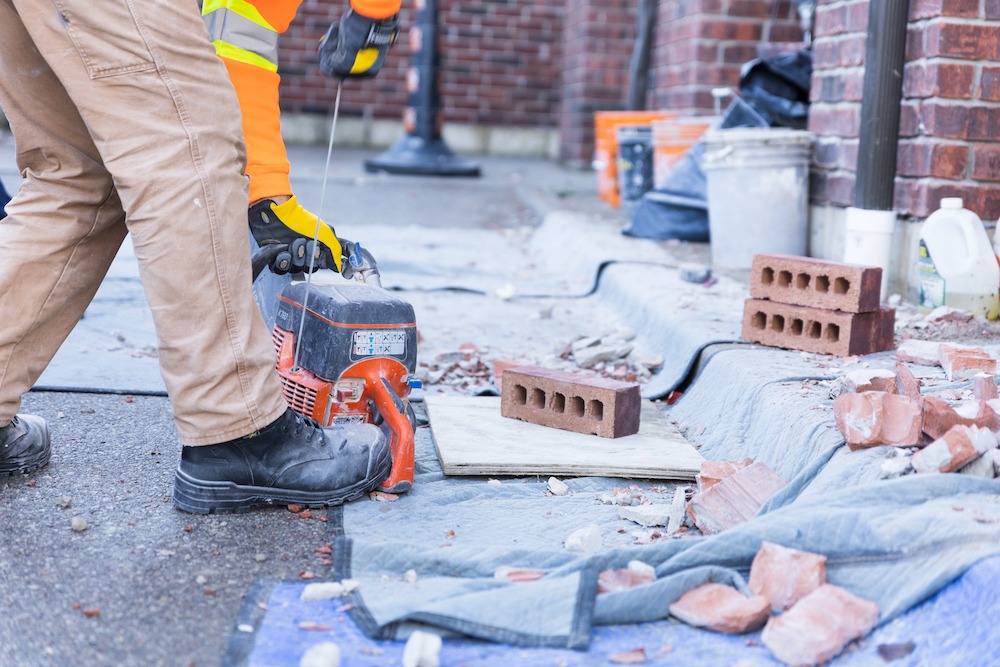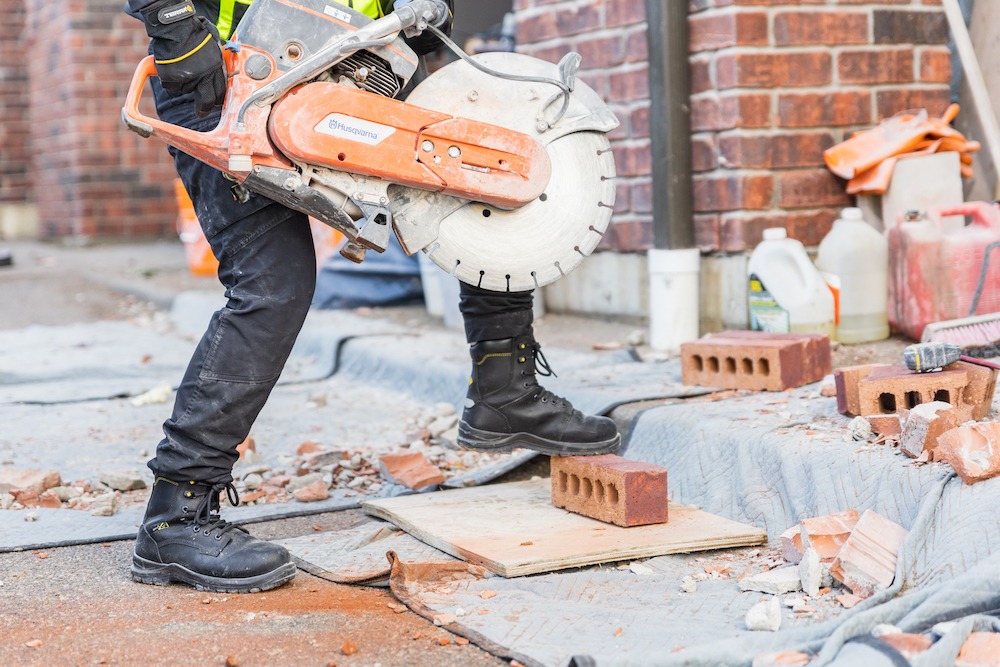Words and Photos: Terra Boots
Working in the masonry industry means long days with a worthwhile payoff, but this comes at the cost of our bodies withstanding a lot. We can sometimes take our feet for granted, but with the right footwear and equipment, those long days and sometimes nights can be made a bit easier. Terra Footwear is here to provide us with eight quick tips for workboots.
Common Care and Maintenance Mistakes
Overall neglect, using the wrong aftercare product and or too much of the aftercare products. In general, masons are wearing leather work boots, and it is important to properly care for the leather to maximize the life of the boots. A routine will help with this, where the wearer sets aside time to look after their work boots.
Take a minute to wipe or brush off any excess mud, cement,t, or other debris that has come into contact with the boots. Pay particular attention to the seams of the boots. Next, kick off any sort of dirt that might be caught in the outsole. At the same time, check to see if anything may be lodged or stuck in the outsole – say a small piece of metal reinforcement, a nail, or even glass. Remove anything and dispose of it accordingly. These are daily steps that can help extend the life of one’s boots.
On a 6 to 8-week schedule, wearers should look to treat their leather boots with either a conditioner of some sort or a waterproofing solution. These should always be water-based products to enhance the natural characteristics of the leather and maintain the original durability.

Ensuring Boot Longevity
The right boot for the job must be chosen at the outset. If you’re going to be working mostly outside, potentially in inclement weather, be sure to avoid an athletic-style work shoe. It will simply not hold up.
Tips And Tricks To Find The Best Work Boot Fit
Purchasing your work boots from a reliable footwear retailer is always our recommendation. A “sit and fit” style store will allow you to browse options in your price range, ask questions about specific requirements, and to most importantly – try the boots on for fit and comfort. A trick that not many people consider is that you should try shopping for boots at the end of the day. Everyone’s feet swell slightly throughout the workday, which will help get the most accurate fit for your feet.
One thing to be fully aware of with safety toe boots is that if they fit snugly in the toe part in any way – they will not “stretch out” or have any give at all. So, it is important to ensure that they are properly sized, especially for safety toe options. If possible, try to mimic a few of the positions you might be working in at your job, and also take a moment to walk the store and even climb some stairs. You will be wearing your work boots longer than almost any of your other footwear, so they must fit and are comfortable. Ensure they are snug around the ankle and that you don’t have any heel slip.

Things To Look Out For When Purchasing Work Boots For The First Time
When buying work boots for the first time, be sure you understand the work environment you are going to be working in and the specific safety requirements for the job. This will help determine the most appropriate safety shoe or boot style for one job function or another.
Things to consider are:
- Indoor or outdoor? What sort of temperatures (extreme heat or cold)?
- Highly mobile or static work?
- Frequent ladders or stairs climbing?
- Driving or vehicle operation?
- What type of chemicals/fluids/hazards might I encounter on the job?
- What is the primary flooring or ground surface I’ll be working on?
All this information will help guide the decision on the best-suited footwear for the wearer. Not all work boots and shoes are built alike – just like not all tools perform the same job. Choosing the correct footwear will allow the wearer to focus on their tasks; choosing the wrong footwear could compromise their comfort or protection and their caliber or quality of work.
Workboot Myths
Protective toecaps do more harm than good.
- Despite the testing and many real-life examples, some wearers still believe that the toe cap – when impacted – crushes or injures the toes. Well, this is just simply not the case. Far more injury would occur without a toe cap.
Protective toes are the generic “steel toe” association.
- Not all protective toes are steel these days, with many made from composites and fiberglass materials. They are lighter, come in many different shapes and profiles, and are engineered to meet all current safety requirements.
Puncture-resistant plates are heavy, inflexible, and make the boot feel hot.
Unlined boots
Issues From Improper Boot Fit
Your work boots provide the foundation you need to perform on the job, and choosing the right safety boots or shoes is critical. Without the correct support, comfort, and durability from your footwear – a wearer could encounter any number of fatigue or motion-related discomfort.
- Foot or leg swelling
- Bunions, corns, and blisters
- Joint pain in knees and hips
- lower back or neck pain
Ultimately, these issues take the focus off the task at hand and can lead to underperformance or distractions that can lead to riskier injuries. By choosing the best-suited footwear for the job, these sorts of issues can be avoided.

Best Work Boots For The Climates
When considering a new pair of footwear, comfort is king, and if you will be working in either extremely hot or extremely cold conditions. You want to be sure your feet are properly equipped. For cold temperatures, look for boots with insulation and probably at least 6” in height. Today, insulations are much less bulky. This technology allows wearers to stay active while not feeling like they are lugging around heavy “winter” boots.
In warm and hot temperatures, make sure you seek a pair with moisture wicking and breathability properties. Full leather boots and boots with waterproof membranes will feel hotter than boots without membranes or with combination fabric plus leather uppers – but a wicking lining can help manage the internal feel of a boot.
Depending on the job, one may wear more athletic style shoes that are made of more breathable performance textiles. If possible, it would be highly recommended to have a pair of spring/summer and fall/winter boots to help navigate the seasons. The upfront cost may seem high but will ultimately help extend the life of one vs. the other.
Warning Signs To Get A New Pair
Just like tires on your car or truck – tread wear is super important for the performance of your work boots or shoes. Special attention should be paid to both the heel and forefoot, as these are the primary locations for take-off and breaking to keep you on your feet.
Also, you want to be sure you are checking for any sort of debris or foreign objects that might be stuck or embedded in any part of the outsole. Small pieces of metal or glass – even small stones could cause traction issues.
On the upper, you want to be watching for any sort of excessive wear – both outside and inside the boots. Cuts or holes in the leather could allow dirt or water to get inside, and any sort of rips or tears in the lining could make for an uncomfortable day.
Lastly, if any sort of major impact has occurred – for boots or shoes with a safety toe – you should consider replacing the footwear. Because these components are inside the boots and hidden from view = there could be damage to any safety components that cannot be seen. This could cause a failure for the next incident.
